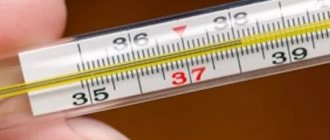What is low-grade body temperature
Low-grade fever is a person’s body temperature with values from 37 to 37.9 degrees inclusive (when measured in the armpit). Low-grade fever is a temperature that lasts several weeks, months or years. At the same time, it does not necessarily have to remain stably at the same values: fluctuations throughout the day are acceptable.
A reading of up to 37.5 degrees does not always indicate the presence of the disease. There are people for whom this is normal. They live with this temperature all their lives and do not feel the slightest problem. However, if your health leaves much to be desired and previously the normal level was 36.6, then there is a pathology.
For an ordinary person, temperature readings from 37 to 38 degrees may be the norm when he:
- just woke up;
- ate heavily;
- playing sports;
- overheated;
- very worried.
Normally, temperature fluctuations during the day are up to 1 degree. But such surges pass quickly and do not cause discomfort.
Why can’t 37 degrees be knocked down?
A slight increase in body temperature cannot be brought down - the body is better able to fight the cause that led to the increase in temperature. With this indicator, the body’s immune system more actively produces killer cells to destroy foreign bacteria and viruses, which helps fight the pathogen.
Recent research by scientists from the UK has introduced some more new facts and explained why the temperature of 37 cannot be reduced. It turns out that the human body at a temperature of 37.2 begins to produce a very useful protein A20, which is involved in suppressing inflammatory processes.
If you lower the temperature, protein will not be produced, which means the healing process is delayed. Taking medications disrupts the body's natural resistance processes.
Symptoms of low-grade fever
If you don’t have a thermometer at hand, you can suspect a temperature that is considered subfebrile based on the following signs:
- Feeling hot and sweating.
- Fogginess of consciousness, although the person remains able to work.
- Discomfort in the mucous membranes of the eyes with dryness and pain.
- Feeling of mild intoxication.
- Lethargy and weakness.
The set of symptoms depends on the cause of the temperature.
For some, low-grade fever occurs only in the evenings, for some - only during the day, and others suffer from constant elevated temperature. Long-term low-grade fever greatly depletes a person. At the stage when he has known about the diagnosis for a long time and cannot help himself, depression and despair develop, which further aggravates the situation.
At the same time, a slightly elevated temperature may occur without symptoms at all.
Necessary tests
Finding out the cause of fever in children is usually as difficult as in adults. To do this, you need to take stool, urine and blood from the child for analysis. Based on the results of these studies, further tactics will be determined. In addition, children are often immediately sent for an ultrasound of internal organs, and X-rays of the lungs and sinuses are taken. It is also recommended to carry out tuberculin tests, blood biochemistry with rheumatic tests, and an ECG.
A special feature of examining children is that pediatricians often advise parents to also be examined. They may also have an underlying infection, but their immune system is not responding properly to the disease and their body is not responding.
Causes of low-grade fever
Let's figure out what diseases are characterized by low-grade fever. After all, this is not an independent diagnosis, but only a symptom. The causes of low-grade fever in adults are as follows.
Infectious low-grade fever
The most common cause of low-grade fever in a person is an infectious inflammatory process: runny nose, pneumonia (read more about the disease here), bronchitis (details here), tuberculosis, gastritis, pancreatitis, etc. The causative agents can be either viruses and bacteria introduced from the outside, or internal opportunistic microflora. Let's list the most common inflammatory diseases that can increase levels in the body:
- ENT inflammation;
- dental problems: carious teeth cause not only low-grade fever, but even cystitis;
- diseases of the gastrointestinal tract;
- inflammation of the genitourinary area (pyelonephritis, cystitis, urethritis, prostatitis, adnexitis, etc.);
- abscesses;
- ulcers in diabetes mellitus.
Let us separately highlight acute rheumatic fever. It is an inflammatory disease of the connective tissue of the heart and joints, caused by streptococcus in people with a genetic predisposition.
The body activates heating to destroy the infection, but there is not enough strength or the infection is sluggish, as a result of which the temperature does not kill the pathogen.
Hepatitis
Viral hepatitis B and C are also the cause of prolonged low-grade fever. The disease is acute or asymptomatic until the moment when it causes irreparable damage to the body.
If low-grade fever is accompanied by muscle and joint pain, discomfort in the right hypochondrium, sweating, weakness and jaundice of the skin, hepatitis should be suspected. You can take a profile test at any clinic.
Post-infectious low-grade fever
Low-grade fever after illness sometimes lasts for some time. This is the so-called temperature tail. The duration depends on the individual characteristics of the body. Someone can say goodbye to a high temperature within a day or two after recovery, while others will need a month or two to six. If the situation has not returned to normal six months after the infection has been eradicated, then it is worth looking for another reason.
In particular, read in a separate article about how low-grade fever manifests itself during and after ARVI (acute respiratory viral infection).
Toxoplasmosis and parasites
Low-grade fever is also a symptom of toxoplasmosis and helminthic infestation. Less commonly, brucellosis.
In a person with a strong immune system, reactions to toxoplasma are vague and the temperature does not last long: the body copes with the problem itself. Toxoplasmosis is dangerous only for pregnant women. With low immunity, they develop a chronic process characterized by low-grade fever.
Brucellosis causes fever, confusion, blurred vision and hearing and is easily diagnosed. It mainly affects rural veterinarians.
Worms cause an inflammatory process in the body, which causes the body temperature to rise. Low-grade fever may be the only symptom of infection.
Damage to the immune system
Low-grade fever can be observed due to problems with the immune system. First of all, this applies to HIV infection and autoimmune diseases: rheumatoid arthritis, lupus, Hashimoto’s thyroiditis, Crohn’s disease, etc.
In autoimmune diseases, chronic inflammation occurs because the body perceives its own cells as foreign and attacks them. After diagnosis, symptomatic treatment is prescribed, but complete healing is impossible. It is only possible to achieve long periods of remission.
HIV infection usually causes symptoms other than fever: nausea, headache, swollen lymph nodes, rash, joint pain. But sometimes low-grade fever comes as the first symptom. HIV is diagnosed after an incubation period of 6 months, then antiretroviral therapy is prescribed.
Read more about the characteristics of temperature during HIV infection in a separate article on temperaturka.com.
Cancer
Low-grade fever, slightly elevated ESR and weakness are reasons, along with infection, to suspect cancer. In cancer, the tumor produces special proteins - endogenous pyrogens, which cause an increase in temperature when released into the blood.
Sometimes low-grade fever is the first sign, six months to a year ahead of other signs of the disease. This is why it is so important to get tested right away. However, doctors start with easily diagnosed diseases, because... Oncological disease in the early stages is difficult to determine in our medical conditions.
In the next article on the website temperaturka.com we will talk about the manifestations of temperature in cancer.
Thyroid dysfunction
With hyperthyroidism (thyrotoxicosis), the thyroid gland works intensely, as a result of which metabolic processes accelerate. Body temperature remains at 37.1-37.3 degrees.
Other signs of the disease: weight loss, hair loss, diarrhea, high blood pressure, tachycardia, irritability, sweating and tremors. But their absence does not exclude thyrotoxicosis.
If the disease develops into a serious form, it threatens disability and death. At the same time, it is not difficult to diagnose.
Anemia
Low-grade fever is accompanied by dizziness, thinning hair and nails, dry skin, drowsiness, decreased immunity, loss of strength, deterioration in general condition, periodic darkening of the eyes, the desire to eat chalk or paper? In this situation, most likely, we are talking about iron deficiency anemia (decrease in the level of hemoglobin in the blood).
Anemia itself is not the last link in the diagnostic chain. It, like a consistently elevated temperature, indicates the presence of other problems. The most common of them is helminthic infestation: parasites literally drink human blood. Anemia is also caused by internal bleeding, unbalanced nutrition, diseases of the stomach and intestines, pregnancy, etc. When the source of the problem is eliminated, the anemia goes away, and after that the thermometer begins to show normal values.
Read more about temperature deviations during anemia in a separate article on temperaturka.com.
Drug-induced low-grade fever
The use of a number of medications (adrenaline, ephedrine, atropine, antidepressants, antihistamines, antipsychotics, antibiotics, narcotics) causes an increase in temperature. It falls within two days after stopping the drug.
Hormonal changes
Low-grade fever is often alarming during hormonal changes in the body. This is typical for teenagers, pregnant women and people in menopause.
Tachycardia (heart rhythm disturbance), hypertension (increased blood pressure), sweating, tremors, cold hands and feet in combination with temperature are typical for pathological menopause.
During pregnancy, there is no need to worry about low-grade fever: it is not dangerous for the fetus if the cause is precisely this interesting condition. However, the doctor must order additional tests to rule out infection and other problems.
VSD and thermoneurosis
Prolonged low-grade fever in a third of patients is explained by psychovegetative causes and is considered a type of vegetative-vascular dystonia (VSD). This condition is also called thermoneurosis: it disrupts thermoregulation in the body. It can occur as a result of past infections, due to disturbances directly in the thermoregulation center (hypothalamus), due to brain tumors, etc.
More often, thermoneurosis occurs in asthenic (i.e. tall and thin) young women, teenagers and freshmen. The disease affects people of a neurotic type with a weak psyche and a severe reaction to stress.
Read more about temperature during VSD in a separate article on temperaturka.com.
Low-grade fever of unknown etiology
The reasons for the elevated temperature are determined after a comprehensive examination. However, sometimes prolonged low-grade fever appears in adults, adolescents and children for no apparent reason. That is, the tests do not show any abnormalities and the studies are normal. Sometimes this indicates a poorly conducted examination. In this case, you should consult another doctor. As a last resort, you will have to wait: perhaps the pathology has not yet manifested itself.
Most often, low-grade fever of unknown etiology is a psychogenic deviation, that is, arising for psychological reasons.
Reasons for women
In addition to the above circumstances, common causes of low fever in women include pathologies of the endocrine glands. In most cases of hormonal disorders, after diagnosing thyrotoxicosis, the disease is confirmed. Men suffer from this pathology much less frequently. Vegetative-vascular dystonia caused by thyroid disease in women is accompanied by an increase in body temperature in the evening.
At a certain period of the menstrual cycle, low-grade fever can be observed due to physiological reasons against the background of normal health. Ovulation (the release of an egg from the follicle) is accompanied by several characteristic symptoms. At this point, women experience slight body heat, swelling, irritability and moderate pain in the lower abdomen. Many girls planning a pregnancy try, thanks to low-grade fever, to determine ovulation by taking daily basal temperature measurements.
During pregnancy
Many expectant mothers worry when they notice 37.5 °C on the thermometer. Doctors note that during pregnancy, in most cases, this condition is a physiological norm. If there are no other warning symptoms (cough, severe weakness or headache), then there is nothing to worry about. Meanwhile, a high temperature can signal the development of the disease. A pregnant woman should seek help if, in addition to fever, she experiences bleeding, pain in the lower abdomen, dizziness or nausea.
- The most effective methods of cleansing the liver with medications and folk remedies at home
- Pneumonia without fever
- Sella turcica in the brain
Diagnosis of low-grade fever
Low-grade fever is identified using a thermometer: the reading remains at 37-37.9 or rises daily at certain hours for a month or longer.
To ensure the purity of the test, a person’s temperature is measured at rest, not immediately after eating, in a sitting position, after washing the armpits with warm water. Sometimes sweat and excess heat accumulate in the armpit, leading to skewed results.
More accurate thermometer readings are obtained in the rectum and mouth. In the first case, the normal temperature ranges from 36.6 to 38 degrees, in the second - from 35.5 to 37.5. You need to hold the thermometer for 10 minutes.
Measurements are taken every 3 hours for two weeks. The results are recorded in a diary. This is important for making a diagnosis. For example, daily fluctuations of more than 1 degree are typical for infectious diseases, with temperatures rising in the late afternoon. The lower the range of daily fluctuations, the lower the likelihood of an infectious cause of low-grade fever.
If the temperature during the day is almost constant or higher in the morning, then non-infectious causes are sought. But leave the right to judge this to the doctor. This information is provided for informational purposes only. We would like to emphasize that the problem requires highly qualified specialists. Most of the diagnoses underlying low-grade fever are not so easily recognized.
Paracetamol test
So, you have correctly measured your body heat for several days and found that the values are regularly elevated. Now you need to independently test with paracetamol or another antipyretic.
The paracetamol test for low-grade fever is carried out as follows. First, at rest and not after eating, body temperature is measured. If it is elevated, then take a paracetamol tablet (500 mg once). Then the person remains at rest and after 2 hours the temperature is measured again. If the thermometer shows normal, this means that the cause of low-grade fever is most likely an infection. If the values on the thermometer remain the same, then the root cause of low-grade fever is more likely to be a non-infectious factor. However, the test is just a guide.
Hint table
Next, we go to the doctor with a temperature diary and test results. The doctor will prescribe a series of standard tests and studies:
- general blood and urine analysis;
- urine analysis according to Nechiporenko;
- blood chemistry;
- electrocardiogram;
- sugar test;
- fluorography and Mantoux test;
- examination by a gynecologist and ENT specialist;
- Ultrasound;
- blood test for hormones;
- thyroid studies;
- blood test for syphilis, hepatitis, HIV and other infections;
- stool analysis for parasites.
In some cases, you will need a computed tomography scan, tests for C-reactive protein, rheumatoid factor and ferritin levels, etc. These studies are prescribed when the doctor has seen the results of the first tests and has a suspicion of a particular disease.
Amidopyrine test
If the research results do not even show whether the subfebrile condition is infectious or not, the doctor conducts an amidopyrine test. The temperature is measured in both armpits and in the rectum before and after taking an antipyretic. Amidopyrine will not reduce body heat in case of thyrotoxicosis and VSD, but for infectious and inflammatory causes the drug will work. The test is carried out for 3 days under the same conditions. The patient's temperature is measured every hour from 6 a.m. to 6 p.m. Amidopyrine is taken only on the second day at 6 a.m. in a dose of 60 ml, and then every hour, 20 ml while taking the temperature. Its decrease on the day of administration indicates the infectious nature of low-grade fever, as well as adenocarcinoma, lymphogranulomatosis and a number of other non-infectious diseases. If the test is negative, a conclusion is drawn about the non-infectious nature of the disease.
Tactics
If you find that your temperature has risen slightly, do not immediately panic and look for signs of serious illness. Perhaps you are simply overtired. To check, take measurements for 1-2 weeks, several times a day. You should go to the doctor if you constantly have a low-grade fever. You will not be prescribed treatment right away. First of all, it is necessary to find the reasons for its increase, and this means a comprehensive examination. Therefore, you should not hope that immediately after your visit the doctor will be able to tell why your body temperature has increased. You need to be prepared to undergo various studies, including ultrasound, x-rays, fluorography, and pass all the necessary tests.
The main thing is not to try to bring down the increased temperature on your own. This will not improve your condition in any way, but it will significantly complicate the diagnosis. In addition, regularly taking antipyretics will not have the best effect on the functioning of your kidneys and liver. It is better to find out what your temperature is, find out how it changes throughout the day, and with this information go to a therapist.
Treatment of low-grade fever
You can bring down a low-grade fever. If you feel unwell because of it, and there is a responsible event ahead, then it can be removed in the same way as a high fever - with antipyretics, for example, paracetamol. But you can't do that often. This is not a treatment, but the elimination of a symptom. Ideally, low-grade fever should not be brought down, but the cause should be removed. In this case, treatment depends on the specific ailment that provokes elevated degrees. If the therapy was successful, the temperature itself returns to normal. This does not always happen immediately after recovery: sometimes it takes up to six months.
What to do if you have a low-grade fever of unknown origin? This conclusion can only be made by a doctor based on an examination. Until then, the genesis is unclear only due to the fact that tests have not been carried out. In cases where even doctors cannot figure out the cause, sometimes psychotherapy helps, since, rather, we are talking about psychosomatics. But it happens that a stressful life situation resolves itself - and the temperature drops.
In cases of thermoneurosis, VSD and psychogenic factors, sedatives, reflexology, acupuncture, homeopathy, hardening, herbal medicine, aromatherapy, meditation, yoga, physical education, hydrotherapy and psychotherapy help. Choose not one, but several directions at once. Also be sure to normalize work and rest schedules, harmony in family and sexual life.
Why does the temperature stay at 37 in children and adults?
At an early age, the body's thermoregulation mechanisms are imperfect, so children under 1 year of age often experience low-grade fever - the normal limit is 37.3 °C. In this case, there is no cause for concern; there is no need to artificially lower the temperature and there is no need to consult a doctor. Later, the causes of low-grade fever in children are identical to the causes that provoke an increase in body temperature in adults. If the temperature is regularly higher than normal, the child complains of weakness and does not eat well, be sure to show him to the pediatrician. A low temperature in a child accompanies the course of diseases such as measles or chickenpox.
In women, the temperature may be higher than normal due to hormonal changes - for example, during ovulation or menstruation. If the temperature remains at 37 ° C for two weeks, this may be a sign of pregnancy. In this case, you need to visit a gynecologist.
A temperature of 37-37.5 °C in men is often associated with stress or injuries received during sports. In the first case, you can fight low-grade fever by normalizing your sleep patterns and taking soothing herbal remedies. As for injuries, eliminating the inflammatory process with medications will also relieve you of fever.
Complications and consequences
There are only three cases in which low-grade fever does not need to be treated and when it is safe:
- Pregnancy, menopause or the period of breastfeeding, when low-grade fever appears against the background of hormonal changes in the female body.
- In infancy, when thermoregulation does not yet work as it should.
- Within 1-2 months (rarely up to six months) after the infection.
In all other cases, low-grade fever should be considered a dangerous symptom. And not the fact of its presence, but the fact that it was caused by unknown reasons that could even kill a person if the disease is allowed to take hold.
Low-grade fever itself is designed to prevent the proliferation of pathogenic organisms and is intended by nature as a benefit. The consequence is an acceleration of metabolism, which gives a slight weight loss effect and increased fatigue. It's not very useful, but it's not deadly either.
In the following article on the website temperaturka.com you can find out what febrile temperature is and what its features are.
Infections
Quite often it happens that prolonged low-grade fever indicates focal diseases.
We can talk about sinusitis, rhinitis, adnexitis, pancreatitis and other similar problems. But it is worth knowing that the body reacts to the appearance of such a lesion only in the case when the immune system is still able to resist. But, unfortunately, a person with such sluggish diseases does not always have a low-grade fever. The reasons for the lack of response to infection should be sought in your behavior. For example, uncontrolled use of antibiotics, non-compliance with the recommended duration of use and dosage of medications leads to the fact that these ailments will be asymptomatic. In addition to the above, low-grade body temperature can be a companion to diseases such as tuberculosis, toxoplasmosis, borreliosis, and brucellosis. It is also often evidence of the development of inflammatory diseases of the joints, eyes, mucous membranes and urinary tract, which arise as a complication of chlamydia or salmonellosis.
It often happens that a low-grade fever persists several weeks after the inflammation has subsided. This phenomenon has not yet been fully studied by specialists. Doctors call this a “temperature tail.”
Comments (3)
Zhanna
11/14/2019 at 08:32 |
When a cold or flu drags on, it's not very good. And it gets harder and harder to endure over time... I recently went through this myself. It’s good that in addition to washing, rinsing, and inhaling, I also started taking Orvis Flu. Apparently he helped me finally get back on my feet. I was also pleased that it does not contain sugar... I am a diabetic and this is a very important point for me))Answer
Victoria
12/18/2019 at 12:05 |
I got sick this fall and had a temperature of 37.4, constantly shivering, and against this background I constantly wrapped myself up warmer and lay there and raised my temperature even higher, only then I learned that you can’t wrap yourself up when you have a chill, but just need to freeze. Once I was frozen and the next morning I was already a cucumber.
Answer
Lena
12/19/2019 at 05:54 |
A slight increase in temperature occurs if you live in a climate that is not suitable for you. Yes, yes, my father lived in the Caucasus for a couple of years (he moved there with his grandmother), so he almost always had a temperature of 37-37.2 and his condition was not very good. We left there immediately and my health improved.
Answer
What to expect from a stronger immune system and how to help it overcome inflammation
Since the cause of low-grade fever is a sluggish inflammatory focus, with a stronger immune system it begins to actively manifest itself in the form of pain, the appearance of various, often purulent, discharges and - most importantly - the temperature rises above 38 degrees. These are very favorable symptoms - they show that your immune system is coping with the disease through its exacerbation .
At temperatures above 38 degrees, our immunity gives the command to produce a substance that kills the infection much better than any synthetic antibiotic and it is called interferon .
You need to understand that now the disease will go from a latent phase to an active one and you will have to be sick for about five days at a high temperature , which cannot be brought down, otherwise after a while the elevated temperature will return again. May you be glad to realize that in this way the hidden illness is coming out of you.
During this period there may be a headache, weakness, heavy sweating, aching pain in the muscles and joints. On the face - a classic exacerbation.
How to help the body and not develop complications
Since immune cells are aimed at intensively killing the infection, the body will see blood temporarily clogged with toxins and dead foreign pathogenic cells. Your help is to help the body remove them naturally as quickly as possible and prevent them from depositing in some tissues and joints, as this can lead to complications.
Your task:
1. Adhere to bed rest while the temperature is high. Put on cotton pajamas and wrap yourself up, sweating conscientiously. Moreover, the temperature in the room should be cool.
What happens if you violate it? A complication affecting the organ that will work intensively during an exacerbation (joints, eyes, ears).
2. Drink plenty of fluids to naturally remove soluble toxins through the kidneys and sweat glands. The best drink is in the form of compotes and herbal tea. Why it is better to drink compote rather than pure water and how much water you should drink per day, find out by following the link. There is an important nuance here: exclude diaphoretic infusions of herbs that contain natural aspirin - linden, viburnum, raspberry and others. Diaphoretic teas reduce the temperature, aspirin blocks the functioning of the kidneys. The liquid is released by the sweat glands, but most of it will remain in the form of dirty lymph and will lie somewhere in the body, creating the basis for chronic diseases in the future.
3. Do not drink either pharmacy or natural aspirin , do not lower the temperature, as this suppresses the immune system, which can cause autoimmune diseases.
4. During an exacerbation, it is necessary to organize increased fluid movement in the intercellular space to more completely flush out toxins. Therefore, it is during this period that we literally “drink like a horse” - up to 5 liters of liquid with honey and lemon. And we drink a little, but often. In this way, you can make the genitourinary system and the sweating system work as much as possible, which will make it possible to naturally remove toxins from pathogenic bacteria, eliminate the hidden source of inflammation that generated low-grade fever and not create deposits of “dirt” in the body for future chronic diseases.
If your temperature suddenly becomes higher than 39 degrees , start intensively drinking various compotes and infusions, since such a temperature is observed when you don’t drink enough and the body’s cooling system does not work.
If you follow all of the above steps, you will safely get rid of the hidden source of inflammation, and therefore the elevated temperature. As a bonus - an increase in the body's defenses.
Now let’s look at elevated temperature in children and women, as well as its occurrence in certain diseases.
Symptoms
Low-grade fever may be accompanied by the following symptoms:
- general weakness and apathy;
- malaise;
- drowsiness;
- loss of appetite;
- body aches;
- muscle pain;
- headache for no apparent reason;
- irritability;
- disruption of the gastrointestinal tract.
Low-grade fever in a child can manifest itself in the form of the following signs:
- moodiness, lethargy;
- deterioration or complete loss of appetite;
- deterioration of sleep - the child may not sleep at all or, conversely, experience excessive sleepiness.
If a child has a low-grade fever for more than 2 days, you should immediately seek medical help and not self-medicate.
Prevention
There is no prevention against low-grade fever as such. If, after examining the patient, the etiological factor of such a disorder has not been identified, you should pay attention to the attitude towards your health. To normalize the condition, the following recommendations can be put into practice:
- avoid stress and nervous tension;
- treat all ailments in a timely manner;
- eliminate bad habits or reduce them to a minimum;
- normalize nutrition and rest;
- introduce moderate physical activity and walks in the fresh air into your regime.
Compliance with such preventive measures will help not only stabilize your health, but also significantly reduce the risk of developing various diseases.
How does a cold occur?
Acute respiratory viral diseases enter the body through infection from a patient through airborne droplets, sneezing, coughing.
Even a short stay in a small room with an infected person can cause infection.
There are many ways to avoid the problem, but the best way is to get immunized.
Scientists are unable to develop a single vaccine, since the influenza virus mutates every 2-3 years and can resist existing immunization drugs .
Therefore, new vaccines have to be developed.
It is necessary to undergo immunization at least 2-3 weeks before the start of the next wave of the epidemic.
You can get more accurate predictions by reading data from immunologist researchers.
During this time, antibodies are produced in the body, and the viral infection will be absolutely harmless. In extreme cases, the disease will pass in a mild form .
How to measure a child's temperature correctly
There is no need to measure the temperature of children:
- immediately after waking up;
- after eating;
- after vigorous physical activity;
- during crying, hysterics, in an excited state.
Indicators may be overestimated for natural physiological reasons. During rest, the temperature may drop. A slight decrease in the bar on the thermometer is also possible if the child has not eaten for a long time. To measure the temperature, you need to wipe the armpit dry. The thermometer should be held tightly and held for at least 10 minutes.
Hidden diseases and pathologies
The presence of a latent infection often has no symptoms, but if the disease is not treated, the patient may develop certain problems.
In case of respiratory tract pathology, an elevated temperature of 37 degrees appears at the initial stage of an acute respiratory disease. If the cold is mild, the patient does not even have symptoms such as a runny nose, and the disease manifests itself through an increase in temperature in the evening.
If a patient has chronic sinusitis, bronchitis, tuberculosis, a body temperature of 37 degrees lasts for a month or more. In this case, indicators may return to normal throughout the day and increase again.
With infections of the genitourinary system such as pyelonephritis or cystitis, a febrile state occurs without symptoms during the prodromal period of the disease. After a few days, a week or a month, symptoms of the disease appear.
In women or men with diseases of the genitourinary system, the reason for the increase in temperature usually lies in a disruption of the hormonal system. When the thyroid gland malfunctions, the rate of biochemical reactions changes.
A latent infection in rheumatism in the form of pathogenic streptococcus affects the heart valves. Proof of its parasitism is an increase in temperature to 37-37.7 degrees, which can last for several days or a week.
If a patient has a bacterial infection of the blood in the form of rubella, measles, mumps, then the increase in temperature will most likely occur without visible symptoms.
Exacerbation of the “chronicle”
The thermometer shows 37 degrees. Fever can be caused by exacerbation of chronic diseases and inflammation in various organs. Dysfunctions of the cardiovascular system and thyroid gland, peptic ulcers, gastritis, pyelonephritis, etc. For a long time, the main symptom of these diseases may be low-grade fever. It may also be accompanied by pain in certain areas. In these cases, you need to contact a specialist. The temperature will return to normal when the inflammation goes away.
Tumors
4:1256
When a malignant tumor develops in the body, all organ systems begin to work differently. Metabolism also changes. As a result, paraneoplastic syndromes arise, including low-grade fever.
4:1635 4:4
A tumor can be suspected after excluding more obvious causes (infection, anemia). When a malignant neoplasm disintegrates, it releases pyrogens into the blood - substances that increase temperature. Often, infections worsen against the background of a tumor, which also causes fever.
4:513 4:518
5:1022 5:1027
Features of paraneoplastic syndromes:
5:1113
- do not respond well to standard therapy for this symptom
- often relapse
- decrease with treatment of the underlying disease (tumor)
Frequent paraneoplastic syndromes:
5:1438 5:1443
Fever that is difficult to treat with antipyretics and anti-inflammatory drugs.
5:1615
Skin manifestations:
5:39
- Acanthosis nigricans (for cancer of the digestive system, breast and ovaries)
- Erythema Daria (with and)
- without rash and obvious reasons
Endocrine signs:
5:311 5:316
6:820 6:825
Blood changes:
6:860
- Anemia (with tumors of different locations). Anemia itself also leads to prolonged low-grade fever.
- Increased ESR (over 30) for a long time
It should be noted that not all cancer patients have obvious paraneoplastic syndromes. And not all of the above signs necessarily indicate a tumor. Therefore, when low-grade fever of unknown etiology appears, especially in combination with other paraneoplastic signs, a thorough examination is necessary.
6:1745 6:4
If you remain symptom-free for a week
If the temperature remains at 37 for a week, the reasons may be hidden in indolent infections. This could be tonsillitis, pharyngitis, consequences of a previous infectious disease, the so-called. "temperature tail". The temperature also rises for some time after vaccination.
Much more severe diseases without visible symptoms cause elevated temperature - helminthiasis, the acute phase of an atypical viral hepatitis.
Is this normal or not?
If a temperature of 37-72.2 lasts for a week, then this is not normal. Normal temperature is from 36 to 36.9. Elevated temperature appears:
- from overwork;
- from a stressful state;
- during pregnancy;
- during menopause;
- during the initial period of lactation.
The conditions listed above do not indicate a disease as such, so a slight increase in temperature of 37 should not alarm you - is this normal or not. There is no need to think about what to do at a temperature of 37 – the body will cope on its own.
Possible causes in adults
Speaking about a clear definition of the reason why a temperature of 37 degrees lasts for a long time and is found in an adult for a long period, it is worth understanding that the process of finding the cause is labor-intensive. In the process of determining the causes of low-grade fever, doctors identified several diseases, which they grouped according to certain characteristics to make it easier to determine the cause of the pathology.
Diseases in which low-grade fever does not change the blood reaction may be the following:
- Premenstrual syndrome - usually appears in women 7-10 days before scheduled menstruation. With the onset of menstruation, body temperature returns to normal. Often, an increase in temperature appears during menopause, especially if the menopause is quite difficult, with psycho-emotional, endocrine and neuro-vegetative disorders.
- Hyperthyroidism – often elevated body temperature for a long time is a sign of existing hyperthyroidism in a person. Additional symptoms appear later.
- Hypothalamic syndrome - body temperature rises against the background of pathology of the hypothalamus, which plays a very important role in thermoregulation of the body. This may be a consequence of intoxication, compression by a tumor, vascular disorders and neuroinfection.
- Low-grade fever in non-infectious pathologies.
There is also a group of diseases in which low-grade fever is accompanied by inflammatory changes:
- Infectious-inflammatory low-grade fever - an increase in temperature in this type of pathology occurs in the presence of foci of infection of a long course. This also includes urogenital, endocrine and bronchogenic infections. Intermittent low-grade fever is recorded in tuberculosis with damage to the lymph nodes and extrapulmonary forms of the disease. Elevated body temperature in this category is recorded in the presence of infectious mononucleosis, brucellosis, toxoplasmosis, hepatitis - all of these are quite rare forms of pathologies that provoke low-grade fever.
- Immune-inflammatory low-grade fever - body temperature rises with chronic hepatitis, juvenile rheumatoid arthritis, inflammatory bowel pathologies.
- Low-grade fever with paraneoplastic reactions - body temperature rises as a reaction of the body to lymphogranulomatosis, malignant neoplasms.
If it rises every evening
An increase in temperature 37 degrees constantly, every evening, may indicate a number of pathologies - these are helminthic infestations, cancer, and myocarditis. If the temperature rises to 37 in the evening without symptoms, this may be a symptom of a number of other diseases.
A regular increase in temperature in the evening may indicate tuberculosis. Therefore, patients with complaints of evening fever should first of all undergo a chest examination.
Tuberculosis was previously a social disease, since it was registered in certain groups of people (isolated from society, people without a fixed place of residence, etc.), but now the pathology has gone beyond this framework and the disease can be diagnosed even in a completely wealthy person who takes care of his health . In addition to a regular increase in temperature, patients lose weight and look tired - these are alarming signs of lung damage.
Why might it happen to women?
If a temperature of 37 without symptoms in women fluctuates within a few divisions, the reasons are mainly associated with fluctuations in hormonal levels and the menstrual cycle. Typically, an increase in temperature is recorded in the second half of the cycle, and with the beginning of menstruation it returns to normal. Another reason for increased body temperature in women is pregnancy - for some expectant mothers, an increase in body temperature in the first trimester is normal.
Specialist consultations
If the test results show that the child has some kind of pathology in the body, then it must be shown to a specialized specialist. But it happens that the disease cannot be detected even with a comprehensive examination. In such cases, pediatricians advise showing the child to a neurologist. This should not be considered an attempt to simply shift a problematic patient onto the shoulders of another specialist. This advice is quite reasonable, because in the absence of changes in the tests, an increase in temperature due to malfunctions in the nervous system cannot be ruled out. In addition, among specialists there is even such a term as “thermoneurosis.”
What should you pay attention to?
Can I read the analysis myself? Yes, and you don't need a medical degree for this. On the resulting form with the result you will see your indicator and norm. The disease will be indicated by an increased number of leukocytes, as well as an upward deviation in the erythrocyte sedimentation rate. But hemoglobin, on the contrary, will be reduced. Such results can be caused by a variety of ailments. For more accurate data, it is necessary to undergo a fluorographic examination, as well as an ultrasound of the pelvic and abdominal organs. This will exclude or confirm a number of diseases, in particular tuberculosis.











